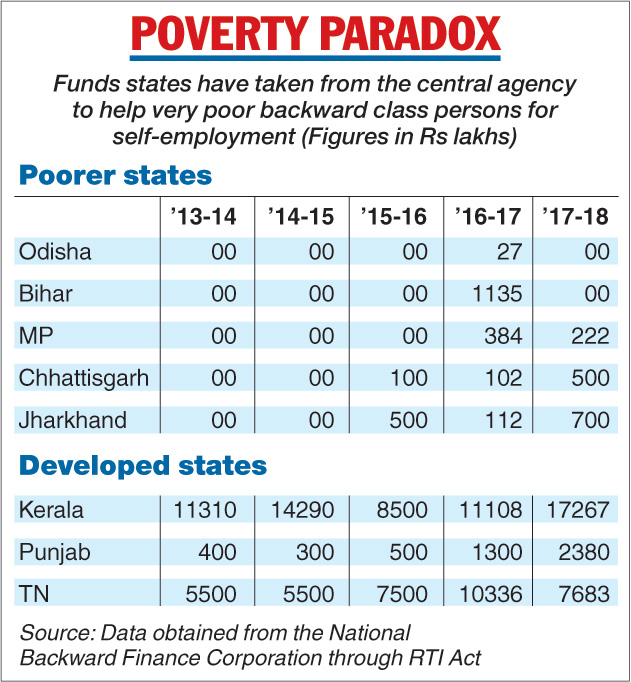The poorer the state, the greater the chance of ignoring central welfare schemes for the most backward classes.
That is what a central agency’s funds disbursement figures for the last five years have revealed.
An application filed under the Right to Information Act has shown that the country’s least developed states have been the worst laggards in accessing funds from the National Backward Classes Finance and Development Corporation.
The NBCFDC provides concessional financial assistance to members from the backward classes (BCs) for self-employment.
Odisha has fared the worst in drawing funds from the central agency since 2013-14, with Bihar, Madhya Pradesh, Chhattisgarh and Jharkhand also figuring among the top laggards.
Odisha was the least developed state in the country, according to a 2013 report of the Committee for Evolving Composite Development Index of States, headed by economist Raghuram Rajan.
The other least developed states were Bihar, Madhya Pradesh, Chhattisgarh and Jharkhand.
Goa was found to be the most developed state, followed by Kerala, Maharashtra, Punjab and Tamil Nadu.
The NBCFDC data showed Kerala, Punjab and Tamil Nadu had all accessed substantial funds from the central agency.
Bengal was at 16th place in the report of the committee headed by Rajan, who was RBI governor between 2013 and 2016.
The state’s funds-access figures were: none for 2013-14, Rs 300 lakh for 2014-15, Rs 250 lakh for 2015-16, Rs 500 lakh for 2016-17 and Rs 303 lakh for 2017-18.
The NBCFDC, a body under the Union ministry of social justice and empowerment, gives advance funds every year to state channelling agencies and channel partners that are supposed to extend loans to eligible persons to help them start income-generating activities.
The channelling agencies are backward class development corporations set up by state governments. The channel partners include public sector banks.
“Funds are disbursed based on government guarantees and fulfilment of certain prudential norms by the state corporations,” NBCFDC managing director K. Narayan said.
The beneficiaries get loans at six or seven per cent under the NBCFDC’s income-generating schemes. The loans are given for ventures like dairies, farming, rearing of goats, fishing, buying tractors, flourmills, small shops, beauty parlours, auto-repair shops, computer centres and photocopier outlets.
People from backward class families with below-poverty-line incomes are eligible for loans. This works out to annual income criteria of Rs 98,000 for a family in rural areas and Rs 1.2 lakh in urban areas.
Professor and economist Kishor Chandra Samal said lack of initiative by state agencies and ineffective leaders among the backward classes were to blame for the poor performance by the poorer states.
“The state government of Odisha in particular does not take the initiative to avail itself of the central funds. It only complains against the Centre on poor funding for political reasons,” Samal said.
He said leaders of other backward classes in Odisha were not aware about the government schemes.
OBCs account for a sizeable chunk of the population in states like Odisha, Bihar, Jharkhand and Chhattisgarh.
“The schemes should be popularised. The leaders should sensitise and help their community to access loans. But that is missing,” Samal said.
Professor Kancha Ilaiah, a well-known author of books on social exclusion, said awareness among eligible beneficiaries was very low in rural areas. “Government employees should take an initiative too. But the effort to create awareness is missing.”

The Telegraph












